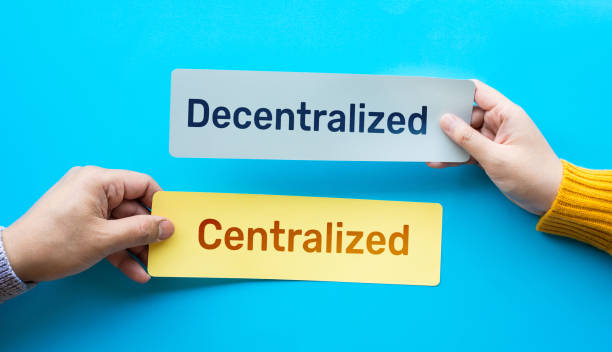Yield farming is a method of generating extra cryptocurrency with your existing cryptocurrency.
It entails you lending your money to others through smart contracts, which are computer programmes.
You receive fees in the form of cryptocurrency in exchange for your services.
Farmers that want to increase their yield will employ more complex tactics.
To maximise their gains, they constantly shift their cryptos between multiple lending marketplaces.
They’ll also keep the best yield farming tactics a well-guarded secret because the more individuals who know about an approach, the less effective it becomes.
Yield farming is the wild west of Decentralized Finance (DeFi), with farmers competing for the greatest crops to farm.
In the blockchain arena, the Decentralized Finance (DeFi) movement has been at the forefront of innovation.
What Distinguishes DeFi Applications From Others?
DeFi apps are permissionless, which means that they can be interacted with by anybody (or anything, like a smart contract) with an Internet connection and a compatible wallet.
Furthermore, they usually do not necessitate faith in any custodians or middlemen.
To put it another way, they are untrustworthy.
So, what new applications are made possible by these properties?
Yield farming is one of the new concepts that has arisen.
It’s a novel approach to earning incentives using permissionless liquidity protocols and bitcoin holdings.
It enables anyone to make passive income by utilising the Ethereum-based decentralised ecosystem of “money legos.”
As a result, yield farming may influence how investors hold their investments in the future.
Why sit on your assets when you can put them to good use?
So, how does a yield farmer care for their crops?
What kind of returns can they anticipate?
And where should you begin if you want to work as a yield farmer?
In this blog post, we’ll go through all of them.
Read: All You Need To Know About Cryptocurrency

What is Yield Farming?
Yield farming, also known as liquidity mining, is a method of earning money from bitcoin assets.
In simple terms, it entails securing cryptocurrency and reaping the benefits.
In some ways, yield farming and staking are similar.
However, there is a great deal of complexity behind the scenes.
It frequently collaborates with liquidity providers (LPs), who contribute funds to liquidity pools.
What is a Liquidity Pool?
A liquidity pool is essentially a smart contract with funds.
LPs are compensated for supplying liquidity to the pool.
This incentive could come from the underlying DeFi platform’s fees or from another source.
Some liquidity pools pay out in a variety of coins.
These reward tokens can then be put into other liquidity pools to receive additional prizes, and so on.
You can see how extremely complicated methods might evolve very fast.
However, the essential concept is that a liquidity provider puts funds into a liquidity pool in exchange for rewards.
Yield farming is usually done on Ethereum with ERC-20 tokens, and the rewards are usually likewise ERC-20 tokens.
Put Your Tech Company on the Map!
Get featured on Nicholas Idoko’s Blog for just $50. Showcase your business, boost credibility, and reach a growing audience eager for tech solutions.
Publish NowHowever, this could change in the future.
Why?
Much of this activity is currently taking place in the Ethereum ecosystem.
Cross-chain bridges and other such improvements, on the other hand, may one day allow DeFi apps to be blockchain agnostic.
As a result, they might run on other blockchains that enable smart contract functionality.
Yield farmers often shift their finances between different techniques to achieve high yields.
As a result, DeFi platforms may offer additional financial incentives to entice more capital to their platform.
Liquidity tends to attract more liquidity, just as it does on centralised exchanges.
Read: Blockchain Use Cases: How the Technology is Being Applied in Various Industries
Types of Yield Farming
Here are the types of yield farming:
- Liquidity provider: To provide trading liquidity, users deposit two coins to a DEX. To switch the two tokens, exchanges charge a nominal fee, which is paid to liquidity providers. This charge might be paid in fresh liquidity pool (LP) tokens on occasion.
- Staking: In the universe of DeFi, there are two types of stakes. On proof-of-stake blockchains, a user gets paid interest in exchange for pledging their tokens to the network as security. The second option is to stake LP tokens obtained by providing liquidity to a DEX. Users can earn interest twice since they are compensated in LP tokens for supplying liquidity, which they can then invest to gain more yield.
- Lending: Coin or token holders can use a smart contract to lend crypto to borrowers and receive interest on the loan.
- Borrowing: Farmers can use one token as collateral for another token loan. The borrowed monies can then be used to farm yield. This allows the farmer to maintain their initial investment, which may appreciate in value over time, while also receiving interest on the borrowed coins.
How Does Yield Farming Work?
Liquidity providers (LPs) are users who contribute their bitcoins to the DeFi platform’s operation.
These LPs contribute coins or tokens to a liquidity pool, which is a decentralised application (dApp) built on smart contracts that hold all of the funds.
When LPs place tokens in a liquidity fund, they are paid a fee or interest based on the underlying DeFi platform that the liquidity pool is running on.
Simply said, it’s a way for you to earn money by lending your tokens through a decentralised application (dApp).
Because smart contracts are used, there is no middleman or intermediary in the financing process.
The liquidity pool powers a marketplace where anyone can lend or borrow tokens.
Users must pay fees to access these marketplaces, which compensate liquidity providers for staking their own tokens in the pool.
The majority of yield farming takes place on the Ethereum platform.
As a result, the payouts are an ERC-20 token.
While lenders can spend the tokens however they choose, the majority are currently speculators looking for arbitrage possibilities by profiting from the token’s market swings.
Read: What is a Cryptocurrency Whitepaper?

What Are the Risks of Yield Farming?
Beyond the regulatory dangers that most digital assets face due to the lack of defined policies addressing cryptocurrencies around the world, cyber theft and fraud are important worries.
All transactions include digital assets stored via software.
Hackers are skilled at finding weaknesses and exploits in software programs to steal money.
Then, there’s the issue of token volatility. Historically, cryptocurrency prices have been known to be erratic.
Short bursts of volatility can occur, causing the price of a token to rise or fall while it is locked in the liquidity pool.
This may result in unrealized gains or losses, and you may be better off if you kept your coins available for trading.
Smart contracts on DeFi platforms aren’t always as reliable as they appear to be.
Many of these developing DeFi protocols are developed by small teams with minimal resources.
This raises the possibility of platform-wide smart contract bugs.
Read: How Smart Contracts Work in Blockchain
Conclusion
In conclusion, yield farming offers a novel way to earn passive income through decentralized finance, but it’s not without its risks.
By leveraging liquidity pools and smart contracts, investors can maximize their cryptocurrency holdings.
However, the volatility of tokens, potential software vulnerabilities, and regulatory uncertainties make yield farming a high-risk, high-reward endeavor.
As the DeFi space continues to evolve, so will the strategies and platforms within it.
Put Your Tech Company on the Map!
Get featured on Nicholas Idoko’s Blog for just $50. Showcase your business, boost credibility, and reach a growing audience eager for tech solutions.
Publish NowFor those willing to navigate its complexities, yield farming presents an exciting opportunity, but caution and thorough research are essential.
Before You Go…
Hey, thank you for reading this blog post to the end. I hope it was helpful. Let me tell you a little bit about Nicholas Idoko Technologies.
We help businesses and companies build an online presence by developing web, mobile, desktop, and blockchain applications.
We also help aspiring software developers and programmers learn the skills they need to have a successful career.
Take your first step to becoming a programming expert by joining our Learn To Code academy today!
Be sure to contact us if you need more information or have any questions! We are readily available.
[E-Books for Sale]
1,500 AI Applications for Next-Level Growth: Unleash the Potential for Wealth and Innovation
$5.38 • 1,500 AI Applications • 228 pages
Are you ready to tap into the power of Artificial Intelligence without the tech jargon and endless guesswork? This definitive e-book unlocks 1,500 real-world AI strategies that can help you.
See All 1,500 AI Applications of this E-Book
750 Lucrative Business Ideas: Your Ultimate Guide to Thriving in the U.S. Market
$49 • 750 Business Ideas • 109 pages
Unlock 750 profitable business ideas to transform your future. Discover the ultimate guide for aspiring entrepreneurs today!
See All 750 Business Ideas of this E-Book
500 Cutting-Edge Tech Startup Ideas for 2024 & 2025: Innovate, Create, Dominate
$19.99 • 500 Tech Startup Ideas • 62 pages
You will get inspired with 500 innovative tech startup ideas for 2024 and 2025, complete with concise descriptions to help you kickstart your entrepreneurial journey in AI, Blockchain, IoT, Fintech, and AR/VR.
We Design & Develop Websites, Android & iOS Apps
Looking to transform your digital presence? We specialize in creating stunning websites and powerful mobile apps for Android and iOS. Let us bring your vision to life with innovative, tailored solutions!
Get Started Today



